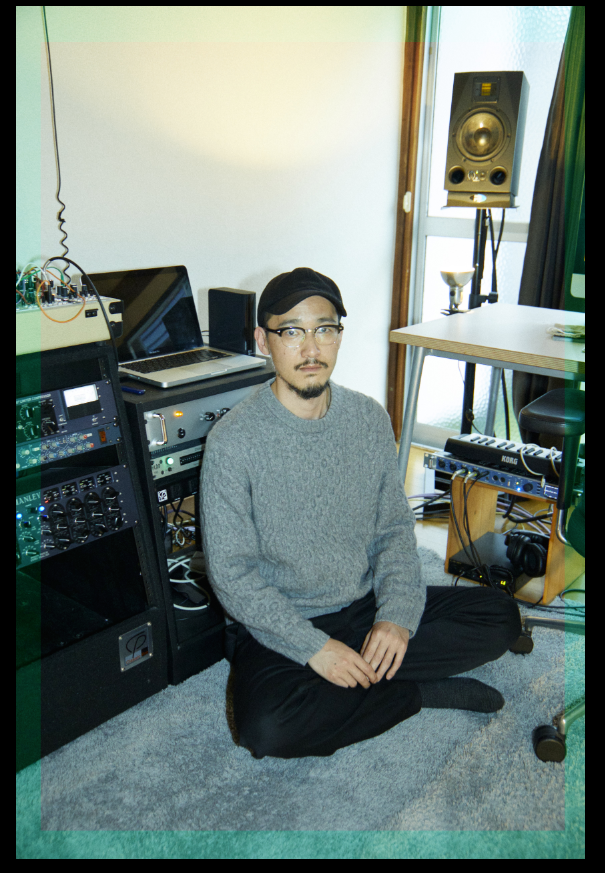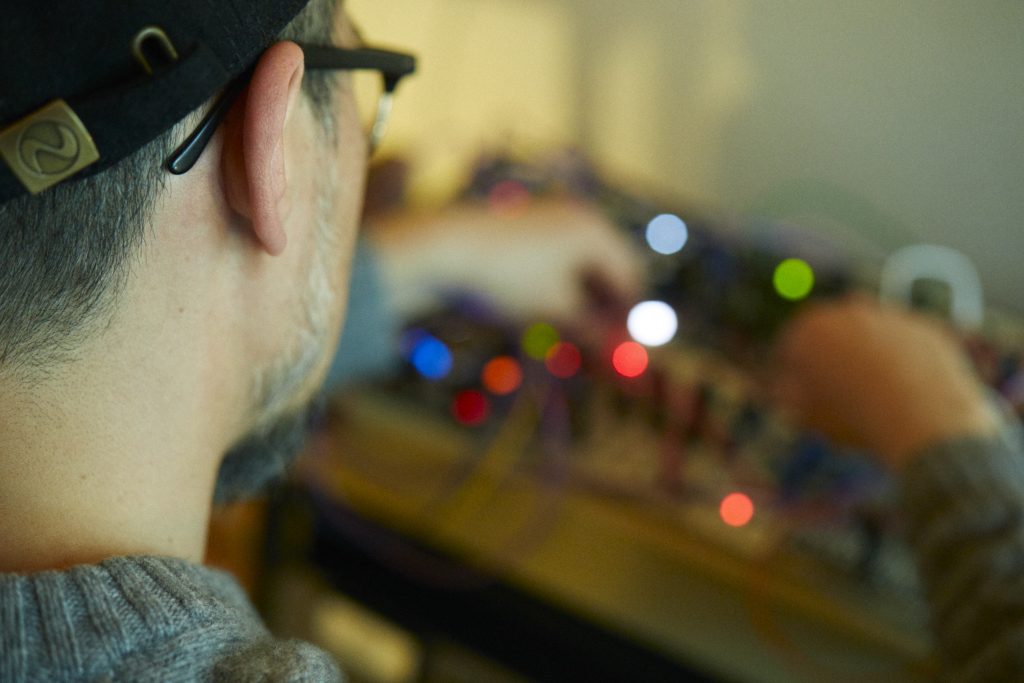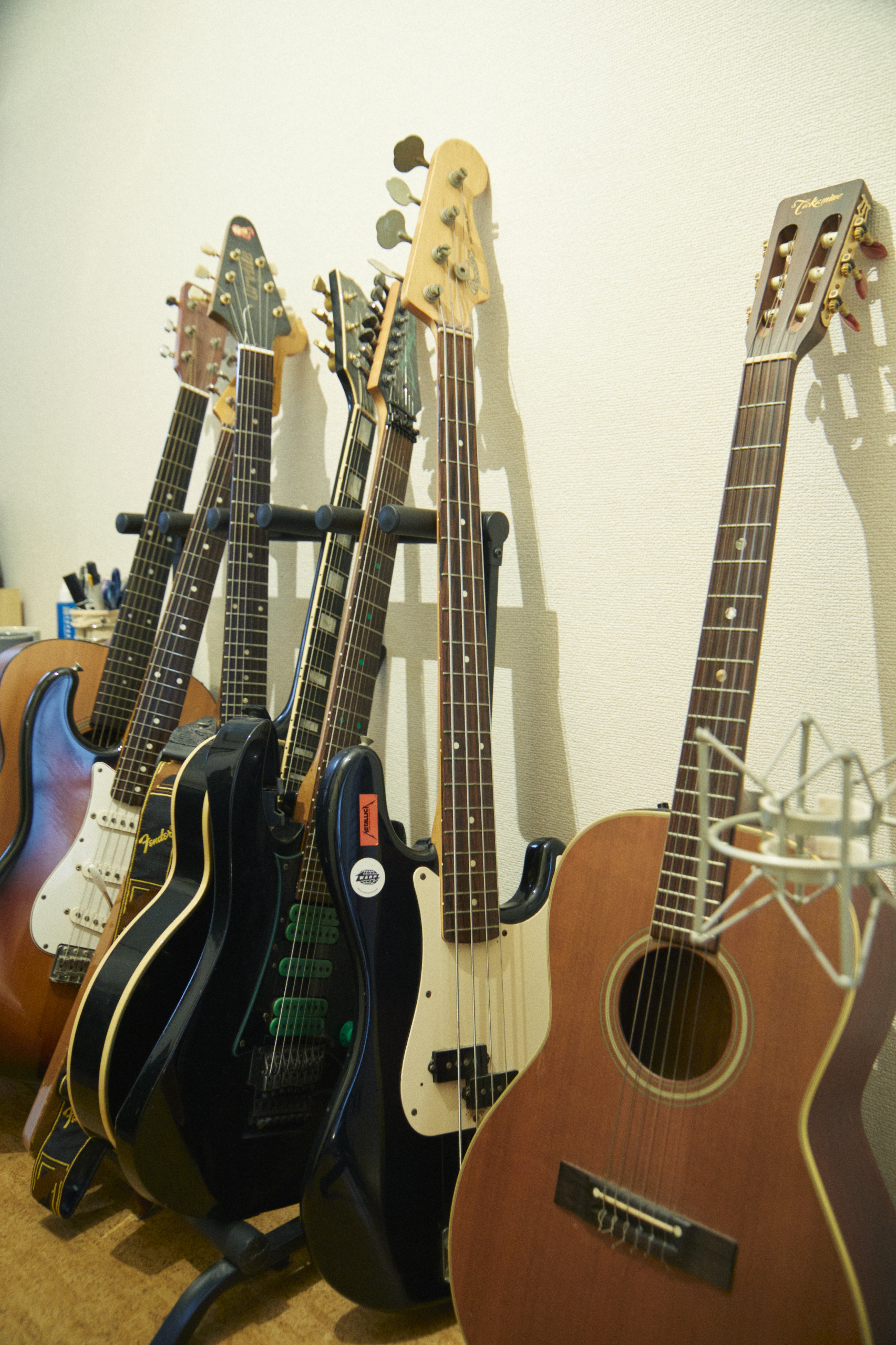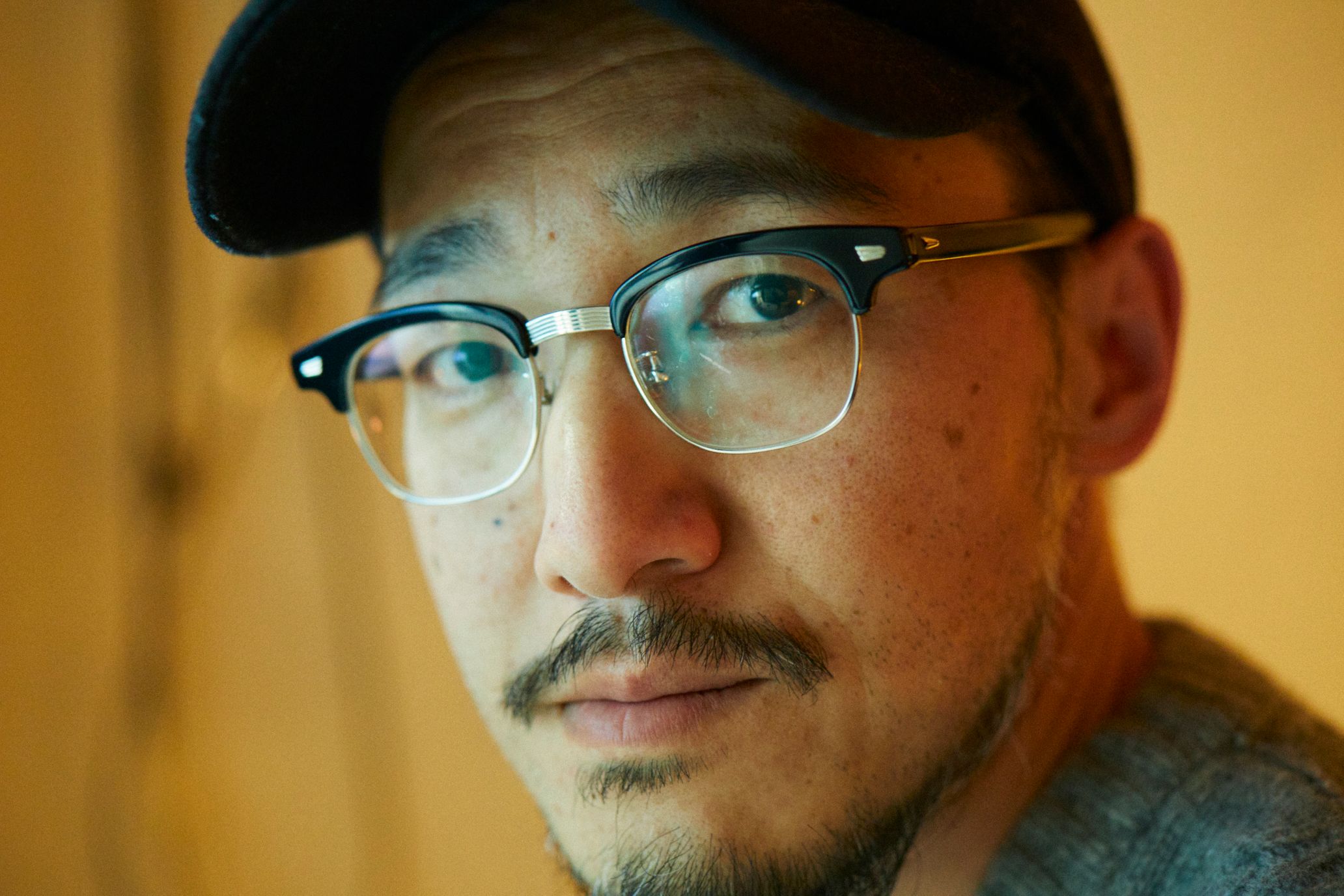Gearbox Records is a London-based music label known for the release of albums by musicians such as Binker and Moses, Theon Cross, and Chiminyo, who have been influential in the thriving UK jazz scene.Many listeners will be surprised to hear the news that Chihei Hatakeyama’s new work “Late Spring” will be released from this label. Since his first full-length album “Minima Moralia” brought out in 2006, he has released more than 70 albums from both domestic and foreign labels and has been leading the ambient / drone scene of the 21st century. What kind of path did he take, and what kind of music did he bring to fruition in his newest work?
The first part of an extensive interview that comes in two parts highlights the background against the release of his work from Gearbox Records, the concept of the new album, the charm of jazz seen through the perspective of ambient / drone, and what led him to the world of ambient music.
Reasons for releasing ambient / drone work from a jazz-oriented label
——Gearbox Records, from which you released “Late Spring” this time, is a label that has actively taken up unreleased historic recordings of jazz and new music in the current UK jazz scene. Can you tell us how you as a musician active in the ambient / drone scene, got to release it form this label?
Chihei Hatakeyama: It was triggered by a phone call from Nick Lascomb, a radio DJ at the BBC in the United Kingdom. He is a person who wrote the liner notes for this album. He has known my music for a long time, but he also had a connection with Gearbox and suggested, “There is a British label called Gearbox, why don’t you release a new album?”. However, when I looked at their lists of records released so far, there was nothing other than jazz albums. So when I asked, “Would it be okay to release my album from that?”, I was told that they would set up a Japanese branch office and start a new electronic music series. That sounded good to me and made me decide to put it out.
——I see, so you were singled out as the first of new series of gearbox. When did the offer come?
Hatakeyama: Last year. However, there was already an album that I had been working on since the end of 2017 and it was about to be completed at the time that I received the offer. So when I sent the recording and asked, “I have this work that is almost done. How about it?”, they said, “Let’s go with this!” So I put the finishing touches on the sound and came to release it.
——You have released albums from various labels both in Japan and overseas, but do you have different musical directions or concepts for each label?
Hatakeyama: The concept is not clearly distinguished from one another, but they are slightly different. As for this newest one, I ended up with an album that was made without assuming the Gearbox. But for example, I have released 5 albums from an Australian label called Room 40, and I have some kind of specific sound image within me for the works released from that label. So, in a sense, I kind of regard the works from Room 40 as a series.
—— In relation to a series of works, you have been releasing a series entitled “Void” from White Paddy Mountain, an independent label run by yourself. The 22nd edition was released in January this year. How do you position this series?
Hatakeyama: Originally, the concept was to release live and unreleased recordings only in a digital format. Since I started it in 2010, a time where physical releases were barely the mainstream, I thought it would be interesting to release works that do not come in a form of object. However, as streaming services such as Spotify and Apple Music gradually became widespread, the Void series turned out to be more popular than the normally released album when I checked at the number of views (laughs). Then, I started to think that it would also be good to release new recordings or ones in a physical format while maintaining the atmosphere of Void. In this way, it gradually moved away from the original concept. The 22nd edition consists only of new songs and was released in a CD format.
——What exactly is the “Void atmosphere”?
Hatakeyama: When you release something physically, you do have to deal with the the issue of inventory. Besides, if you put it out from another label, you have to worry about sale as well. The first concept was to release the sound that I love without considering such commercial aspects. So originally, lengthy drones were its main focus, but this has also been changing gradually. Especially after the corona pandemic, I myself have become less motivated to listen to and write long songs. So lately, I’ve been recording and releasing short songs of 3-4 minutes. However, this state of mind is also changing now, and recently I’ve been making a slightly longer song of 7 to 8 minutes.
What David Lynch, Yasujiro Ozu, and “Wabi-Sabi” have in common: the underlying factor of newest album
—— “Late Spring” is also a work that contains a lot of short pieces of 3 to 4 minutes. I found it interesting that you had limited number of the instruments used such as synthesisers and guitars for each song. What was the new challenge for you in this work?
Hatakeyama: Since I had got all the settings of the modular synths satisfactorily prepared, I decided to play a song only with it, which was a big challenge for me. I also changed the recording method for electric guitars. With different recording method, I come up with the different idea through it. As a result, I used the acoustic guitar only for the 7th song “Thunder Ringing in the Distance”, which was recorded with a dedicated recording method. This song was a one-take recording of an acoustic guitar improvisation, and I didn’t add electronic sounds in the post-production process. However, I captured the guitar sounds using a microphone and processed them with a mixing console and effects pedals on the spot, which ended up with the sounds that do not seem to be acoustic guitar sounds. That was one of the ideas that came out of the specific recording method, and something I tried this time.
——If you think of each song as a “solo improvisation with a synth or guitar,” it would be fun to listen to it along with ambient-textured jazz. Did you have any people or works that inspired you to make the album?
Hatakeyama: There are several, but the biggest one was “Twin Peaks The Return,” which was broadcast in 2017. The new series was broadcast for the first time in 25 years and became a hot topic. Inspired by the taste of video and sounds of it, I made a song called “Spica”, combining improvisational sound of analog synth called Prophet-5, with a kind of glitch-noises generated through a modular. I also made “Butterfly’s Dream” 1 and 2 in the same way.
—— “Twin Peaks” is known as a masterpiece of director David Lynch, but the title of the new album reminds me of Yasujiro Ozu’s movie “Late Spring” (1949).
Hatakeyama: Of course, the title of “Late Spring” comes from Ozu’s “Late Spring”. Yasujiro Ozu and David Lynch are completely different as film directors, but I think they are connected. If you look deeply into the heart of philosophy of ”Twin Peaks”, you will find Eastern thought. David Lynch is influenced by the so-called Transcendental Meditation and Buddhist ideas, and there are a bunch of people interpreting the story of “Twin Peaks” through the lens of Buddhism. The taste of Yasujiro Ozu is not Buddhism itself, but there is a part where its spirituality is mixed in, and I think that they have something in common in that sense.
In terms of this album, the concept is to “find a good takes from one-take improvisational recordings” and to embody the Japanese aesthetic “Wabi-Sabi”, as exemplified by the no-frills taste of the Japanese tea room. The root of aesthetic of the tea ceremony is Zen Buddhism. In this way, David Lynch, Yasujiro Ozu, and “Wabi-Sabi” were all connected in my mind, and I entitled this album “Late Spring.”
——When I listened to the album all the way through it, it seemed as if scenes of a certain day came to my mind, as shown in the sequence of song titles, which started at dawn and ended in the evening. When did you name the song?
Hatakeyama: I name songs always at the end. When all the songs have been sorted out, the album name is decided first, and the individual song names are considered after that. I give each song a name that would match its sound and atmosphere, while correlating it with the album title. Recently, more and more people are listening to each song on a streaming service, so I’m trying to place more value on the song title for each song. But this time, I give names to create film-like flow, and story that would function as a guide for listeners all the way through it.
The charm of jazz seen through the lens of an ambient / drone
——In relation to albums released from jazz-oriented labels, there was also “Sacrifice For Pleasure” released from the Airplane label in 2013. In particular, the songs featuring Hiroki Chiba’s violin / contrabass and Jimanica’s drums had an atmosphere that could be called ambient jazz.
Hatakeyama: That’s right. However, for that work, it wasn’t a one-take recording like “Late Spring”, but in fact I placed great importance on the editing process. I recorded it with Chiba and Jimanica in 2008, and I still remember vividly that we were struggling to get it into shape. At that time, I invited them because I was thinking of doing electro-acoustic music in a band format like the Radian from Vienna. However, we did not continue it as a band, and as a result it was contained in that album. I still want to do jazz-like ambient in a band format if I get the chance.
——What kind of jazz do you like?
Hatakeyama: When I was young, I liked free jazz, but from around the age of 35, modern jazz became more comfortable to me. I sometimes listen to modern jazz playlists on Spotify. However, I still like the so-called spiritual jazz such as Sun Ra and Alice Coltrane. In terms of Sun Ra, I like the melodic and melancholic sound image, or the archaic atmosphere with chorus, rather than the chaotic sounds recorded with many other members. Masterpieces such as “Sleeping Beauty” (1979) and “Cosmos” (1976) are my favorite. I love the sound of strings and piano combined with phaser sound effects.
—— “Lanquidity” (1978) has that kind of atmosphere as well, doesn’t it? By the way, music critic Masaaki Hara have featured Miles Davis’s “In A Silent Way” (1969) and “Get Up With It” (1974) as an ambient music in “TOKION”. What do you think about these ones?
Hatakeyama: Of course I also like Miles Davis. But what I like most about Miles is actually a 6-disc box set that contains the session that was an original recording of “On The Corner” (1972). “On The Corner” itself is often talked about in the context of funk, but I prefer a raw form of the session before being edited. I often listen to it as an ambient music.
——In Masaaki Hara’s essay, he also mentioned Masabumi Kikuchi’s synth solo and Yasuaki Shimizu’s work as ambient-oriented jazz born under the influence of Miles and Brian Eno. In recent years, these works have received renewed interest in the context of new age / ambient revival. How do you perceive these 1980s Japanese ambient-oriented jazz?
Hatakeyama: Looking back on the early 2000s when I started making ambient music, to be honest, Yasuaki Shimizu’s music sounded a little outdated to me. At that time, the sounds of musicians like Autechre and Fennesz, the music released from Warp and Mego felt very fresh. About 10 years later, I finally started listening to Japanese ambient music in the 1980s. In 2019, the compilation album “Kankyō Ongaku” was released, and there were many musicians I had never heard in it. However, I’ve liked and been listening to Hiroshi Yoshimura and Satoshi Ashikawa since the 2000s.
The trigger for entering into the world of ambient music
——When you started making ambient music, did the albums of Hiroshi Yoshimura and Satoshi Ashikawa also become a source of inspiration?
Hatakeyama: No, I started listening to it after I started making the ambient music. Before that, I was obsessed with the electronica from Warp and Mego, and the post-rock sounds released from Japanese Indie label HEADZ. A laptop PC I bought around that time became a trigger for me because it made me decided to do laptop music. I also listened to Jim O’Rourke a lot and went to live many times. I also liked Gastr del Sol’s “Camoufleur” (1998). Also, David Grubbs came to Japan and went to see the live performance at Aoyama CAY, which was also insanely good. Around that time, I started going to improvisational live performances a lot.
——Not through Brian Eno, but you entered the world of ambient music through electronica and post-rock.
Hatakeyama: That’s right. Of course I was listening to Brian Eno, but at that time his music also sounded outdated to me. Now I don’t think it is outdated anymore. But Eno did not provide a spark for me to start ambient.
——In relation to Eno, he is also known as a person who has presented the ambiguity of “interesting but negligible” as the definition of ambient music. In this work “Late Spring”, you can listen to it while relaxing, but if you listen carefully, you can find many interesting moments such as a faint noise and a sudden irregular movement of a minimal phrase. What do you think about the ambiguity of the ambient music presented by Eno?
Hatakeyama: Not only for this work, I am always conscious of the ambivalent shape of music mentioned by Eno. Sometimes I concentrate on listening to music, and other times I listen to it as BGM while reading a book. When my album is completed, I don’t just listen to it to check it, but I also read the book while listening to it, looking for something that would get in the way. I am trying to fix it if something captures my attention too much when I listen to it as a BGM.
Chihei Hatakeyama
He released a solo album “Minima Moralia” from Chicago-based avant-garde music label Kranky under the name of Chihei Hatakeyama in 2006. Since then, he has released many works from independent labels in Japan and overseas, such as Rural Colors in the UK, Under The Spire, Room 40 in Australia, and Home Normal in Japan, and has also performed live tours overseas. He is well known abroad and was ranked in the top 10 of Spotify’s 2017 “Most Played Japanese Artists Overseas”. In April, the album “Late Spring” was released from Gearbox Records in the UK.
Photography Teppei Hoshida
Edit Jun Ashizawa(TOKION)
Translation Shinichiro Sato(TOKION)





